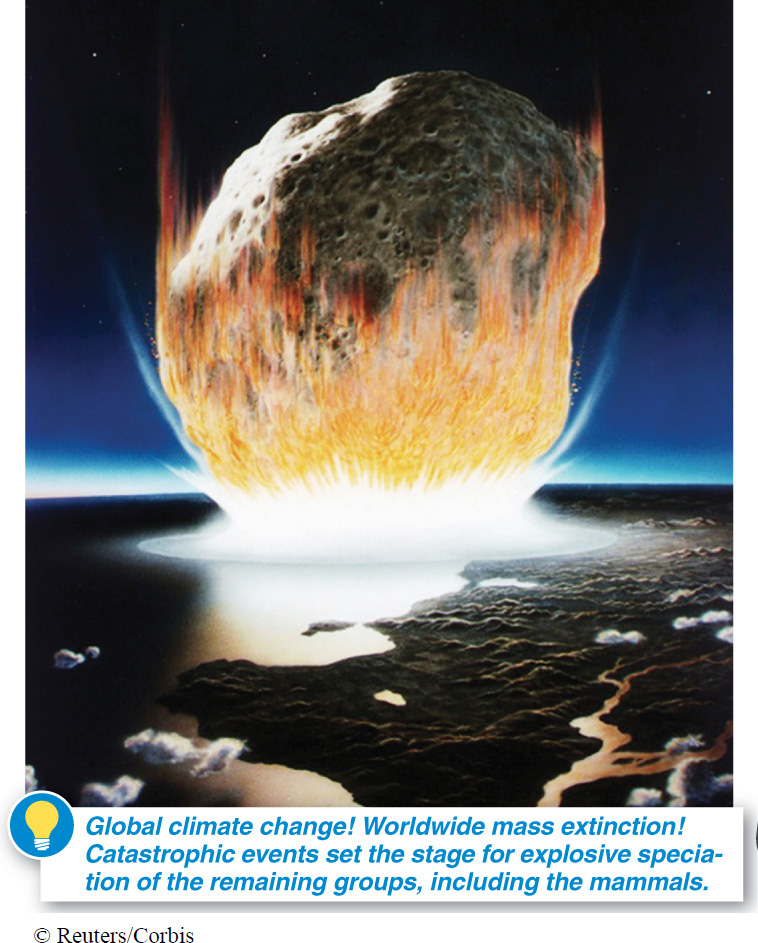“Forests keep disappearing, rivers dry up, wild life’s become extinct, the climate’s ruined and the land grows poorer and uglier every day.”
— ANTON CHEKHOV, Uncle Vanya, 1899
If the past is a guide to the future, we know this: no species lasts forever. Speciation is always producing new species, but extinction, the complete loss of all individuals in a species population, takes them away. Extinction is always occurring and is faced by all species.
For any given time in earth’s history, it is possible to estimate the rate of extinctions. This rate can be expressed in several difference ways, such as the number of species that go extinct over a given period of time. And the evidence reveals that these rates are far from constant (FIGURE 10-25). Although the details differ in most cases, extinctions generally fall into one of two categories: “background” extinctions or mass extinctions.

While extinctions are occurring all the time, background extinctions are those that occur at lower rates, during periods other than times of mass extinctions. Background extinctions occur mostly as the result of natural selection. Competition with other species, for example, may reduce a species’ size or the range over which it can roam or grow. Or a species might be too slow to adapt to gradually changing environmental conditions and becomes extinct as its individuals die off.
Mass extinctions are periods during which a large number of species on earth become extinct over a relatively short period. There have been at least five mass extinctions on earth and, during each of these extinctions, 50% or more of the animal species living at the time became extinct.
There is a fundamental difference between background and mass extinctions that goes beyond differences in rates. They have different causes. Mass extinctions are due to extraordinary and sudden changes to the environment (such as an asteroid impact). As a consequence, nothing more than bad luck is responsible for the extinction of species during mass extinctions; fit and unfit individuals alike perish.
Of the five mass extinctions during the past 500 million years, the most recent is also the best understood: the asteroid crash, described in the previous section, that cleared the way for our mammalian ancestors to diversify. This massive asteroid smashed into the Caribbean near the Yucatán Peninsula of Mexico 65 million years ago (FIGURE 10-26). The impact left a crater more than 100 miles wide and probably created an enormous fireball that caused fires worldwide, followed by a cloud of dust and debris that blocked all sunlight from the earth and disturbed the global climate for months. In the aftermath of this catastrophe, about 75% of all species on earth were wiped out, including almost all dinosaurs, a tremendously successful group that had been thriving for 150 million years. (Among the rare surviving dinosaurs were those that would become the birds.)

As bad as the dinosaur-
431
An important question now being debated is whether we are currently in the midst of a human-
TAKE-HOME MESSAGE 10.14
As new species are being created, others are lost through extinction, which may be a consequence of natural selection or large, sudden changes in the environment. Mass extinctions are periods during which a large number of species on earth become extinct over a short period of time.
What is the fundamental difference between background and mass extinctions, other than differences in rates?
Background extinctions are caused mostly as a result of natural selection. Mass extinctions are due to extraordinary and sudden changes to the environment, such as the asteroid that brought about the extinction of the dinosaurs.
432